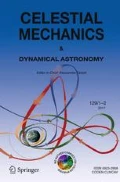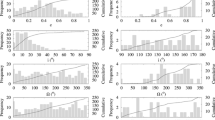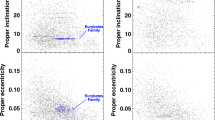Abstract
Over the course of the last decade, observations of highly inclined (orbital inclination i > 60\(^\circ \)) trans-Neptunian objects (TNOs) have posed an important challenge to current models of solar system formation (Levison et al. in Icarus 196(1):258–273, 2008; Nesvorný in Astron J 150:73, 2015). These remarkable minor planets necessitate the presence of a distant reservoir of strongly out-of-plane TNOs, which itself requires some dynamical production mechanism (Gladman et al. in Astron J Lett 697:L91–L94, 2009; Gomes et al. in Icarus 258:37–49, 2015; Batygin and Brown in Astrophys J 833(1):L3, 2016). A notable recent addition to the census of high-i minor bodies in the solar system is the retrograde asteroid 514107 Ka’epaoka’awela, which currently occupies a 1:-1 mean motion resonance with Jupiter at i = 163\(^\circ \) (Wiegert et al. in Nature 543:687–689, 2017). In this work, we delineate a direct connection between retrograde Jupiter Trojans and high-i Centaurs. First, we backpropagate a large sample of clones of Ka’epaoka’awela for 100 Ma numerically and demonstrate that long-term stable clones tend to decrease their inclination steadily until it concentrates between 90\(^\circ \) and 135\(^\circ \), while their eccentricity and semi-major axis increase, placing many of them firmly into the trans-Neptunian domain. Importantly, the clones show significant overlap with the synthetic high-i Centaurs generated in Planet 9 studies (Batygin et al. in Phys Rep 805:1–53, 2019), and hint at the existence of a relatively prominent, steady-state population of minor bodies occupying polar trans-Saturnian orbits. Second, through direct numerical forward modeling, we delineate the dynamical pathway through which conventional members of the Kuiper Belt’s scattered disk population can become retrograde Jovian Trojan resonators in the presence of Planet 9.




Similar content being viewed by others
Notes
We note that in chaotic dynamics, forward and backward integrations are statistically equivalent.
We parallelized our simulation into 62 subprocesses with 100 test particles each. The cloning is done inside these sub-simulations, such that whenever the resampling is triggered by having less than 25 of the initial 100 particles left, the leftover objects are (randomly assigned) parents for as many clones that are needed to reach 100 objects again.
The Lyapunov time is estimated with the REBOUND software containing the Sun, the four outer planets and Ka’epaoka’awela. The IAS15 integrator (Rein and Spiegel 2015) is used with a time step of 100 days.
Although the initial conditions for the TNO population have been taken from a simulation with Planet 9, the particles have been propagated forward in time without Planet 9, as we do not expect the planet to have a significant influence on the test particles’ trajectories once they begin their journey to the inner planets. The observation that these high-inclination TNOs exist in the first place is independent of their assumed method of generation: We merely show that their population could explain the presence of polar SSSBs co-orbital to the giant planets.
We performed the same simulation without Planet 9 and reach comparable results. This is expected since the particles observed are far enough away from Planet 9 to not be significantly affected. We therefore omit a more detailed presentation in order to avoid repetition of the conclusions.
In this case, the positions of the planets are therefore different to what the initial test particle population experienced. This is not a problem, however, for two reasons: First, the 119 original particles were extracted at different times (i.e., positions of planets) already, but most importantly, the entering of the polar corridor is, to an excellent approximation, independent of the positions of the planets (Batygin and Morbidelli 2017; Li et al. 2018).
We note that this is most likely an underestimate, since from a code framework perspective, we are restricted to analyzing the orbits at the output time steps of 10 ka. We are therefore missing all particles that enter and leave a planet’s influence in between the snapshots.
We find a similar capture rate into the 1:1 resonance for the clones of the prograde particle.
References
Armitage, P.J.: Dynamics of protoplanetary disks. Ann. Rev. Astron. Astrophys. 49(1), 195–236 (2011). https://doi.org/10.1146/annurev-astro-081710-102521
Batygin, K., Brown, M.E.: Generation of highly inclined trans-neptunian objects by planet nine. Astrophys. J. 833(1), L3 (2016). https://doi.org/10.3847/2041-8205/833/1/L3
Batygin, K., Morbidelli, A.: Dynamical evolution induced by planet nine. Astron. J. 154(6), 229 (2017). https://doi.org/10.3847/1538-3881/aa937c
Batygin, K., Adams, F.C., Brown, M.E., Becker, J.C.: The planet nine hypothesis. Phys. Rep. 805, 1–53 (2019). https://doi.org/10.1016/j.physrep.2019.01.009
Chambers, J.E.: A hybrid symplectic integrator that permits close encounters between massive bodies. Mon. Not. R. Astron. Soc. 304(4), 793 (1999). https://doi.org/10.1046/j.1365-8711.1999.02379.x
Gallardo, T.: Orbital stability in the Solar system for arbitrary inclinations and eccentricities: planetary perturbations versus resonances. Mon. Not. R. Astron. Soc. 487, 1709–1716 (2019). https://doi.org/10.1093/mnras/stz1419
Gladman, B., Kavelaars, J., Petit, J.M., Ashby, M.L.N., Parker, J., Coffey, J., et al.: Discovery of the first retrograde transneptunian object. Astrophys. J. Lett. 697, L91–L94 (2009). https://doi.org/10.1088/0004-637X/697/2/L91
Gomes, R.S., Soares, J.S., Brasser, R.: The observation of large semi-major axis centaurs: testing for the signature of a planetary-mass solar companion. Icarus 258, 37–49 (2015). https://doi.org/10.1016/j.icarus.2015.06.020
Greenstreet, S., Gladman, B., Ngo, H., Granvik, M., Larson, S.: Production of near-earth asteroids on retrograde orbits. Astrophys. J. 749(2), L39 (2012). https://doi.org/10.1088/2041-8205/749/2/L39
Hudson, R.L., Palumbo, M.E., Strazzulla, G., Moore, M.H., Cooper, J.F., Sturner, S.J.: Laboratory studies of the chemistry of transneptunian object surface materials. In: Barucci, M.A., Boehnhardt, H., Cruikshank, D.P., Morbidelli, A. (eds.) The Solar System Beyond Neptune Space Science Series, pp. 507–523. The University of Arizona Press, Tucson (2008)
Jones, R.L., Juric, M., Ivezic, Z.: Asteroid discovery and characterization with the large synoptic survey telescope (LSST). Proc. Int. Astrono. Union 10(S318), 282–292 (2015). https://doi.org/10.1017/S1743921315008510. arXiv: 1511.03199
Kaib, N.A., Pike, R., Lawler, S., Kovalik, M., Brown, C., Alexandersen, M., et al.: OSSOS XV: probing the distant solar system with observed scattering TNOs. Astron. J. 158(1), 43 (2019). https://doi.org/10.3847/1538-3881/ab2383. arXiv: 1905.09286
Levison, H.F., Morbidelli, A., VanLaerhoven, C., Gomes, R., Tsiganis, K.: Origin of the structure of the Kuiper belt during a dynamical instability in the orbits of uranus and neptune. Icarus 196(1), 258–273 (2008). https://doi.org/10.1016/j.icarus.2007.11.035
Li, G., Hadden, S., Payne, M., Holman, M.J.: The secular dynamics of TNOs and planet nine interactions. Astron. J. 156, 263 (2018). https://doi.org/10.3847/1538-3881/aae83b
Li, M., Huang, Y., Gong, S.: Survey of asteroids in retrograde mean motion resonances with planets. Astron. Astrophys. 630, A60 (2019)
Lithwick, Y., Naoz, S.: The Eccentric Kozai mechanism for a test particle. Astrophys. J. 742(2), 94 (2011). https://doi.org/10.1088/0004-637X/742/2/94. arXiv: 1106.3329
Murray, C.D., Dermott, S.F.: Solar System Dynamics. Cambridge University Press, Cambridge (2000)
Namouni, F., Morais, M.H.M.: Resonance capture at arbitrary inclination. Mon. Not. R. Astron. Soc. 446(2), 1998–2009 (2015). https://doi.org/10.1093/mnras/stu2199
Namouni, F., Morais, M.H.M.: An interstellar origin for Jupiter’s retrograde co-orbital asteroid. Mon. Not. R. Astron. Soc. Lett. 477(1), L117–L121 (2018). https://doi.org/10.1093/mnrasl/sly057
Nesvorný, D.: Evidence for slow migration of neptune from the inclination distribution of Kuiper Belt objects. Astron. J. 150, 73 (2015). https://doi.org/10.1088/0004-6256/150/3/73
Press, W.H., Teukolsky, S.A., Vetterling, W.T., Flannery, B.P.: Numerical Recipes 3rd Edition: The Art of Scientific Computing, 3rd edn. Cambridge University Press, Cambridge (2007)
Rein, H., Spiegel, D.S.: IAS15: a fast, adaptive, high-order integrator for gravitational dynamics, accurate to machine precision over a billion orbits. Mon. Not. R. Astron. Soc. 446, 1424–1437 (2015). https://doi.org/10.1093/mnras/stu2164
Volk, K., Malhotra, R.: Do centaurs preserve their source inclinations? Icarus 224, 66–73 (2013). https://doi.org/10.1016/j.icarus.2013.02.016
Wiegert, P., Connors, M., Veillet, C.: A retrograde co-orbital asteroid of Jupiter. Nature 543, 687–689 (2017). https://doi.org/10.1038/nature22029
Wisdom, J., Holman, M.: Symplectic maps for the n-body problem: stability analysis. Astron. J. 104, 2022 (1992). https://doi.org/10.1086/116378
Acknowledgements
We thank Nathan A. Kaib and a second anonymous reviewer for their valuable comments and suggestions for improving this manuscript. This research has made use of data and/or services provided by the International Astronomical Union’s Minor Planet Center. Simulations in this paper made use of the REBOUND code which is freely available at https://github.com/hannorein/rebound. KB gratefully acknowledges the David and Lucile Packard Foundation and the Alfred P. Sloan Foundation for their generous support.
Author information
Authors and Affiliations
Corresponding author
Additional information
Publisher's Note
Springer Nature remains neutral with regard to jurisdictional claims in published maps and institutional affiliations.
This article is part of the topical collection on Trans-Neptunian Objects.
Guest Editors: David Nesvorny and Alessandra Celletti.
Rights and permissions
About this article
Cite this article
Köhne, T., Batygin, K. On the dynamical origins of retrograde Jupiter Trojans and their connection to high-inclination TNOs. Celest Mech Dyn Astr 132, 44 (2020). https://doi.org/10.1007/s10569-020-09985-1
Received:
Revised:
Accepted:
Published:
DOI: https://doi.org/10.1007/s10569-020-09985-1




